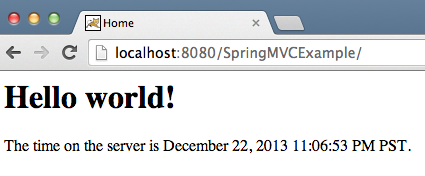Introdução
A classe HttpURLConnection do pacote java.net pode ser utilizada para enviar programaticamente uma requisição HTTP em Java. Neste artigo, você aprenderá como usar HttpURLConnection em um programa Java para enviar requisições GET e POST e então imprimir a resposta.
Pré-requisitos
Para este exemplo de HttpURLConnection, é necessário ter concluído o Tutorial do Spring MVC pois ele contém URLs para os métodos HTTP GET e POST.
Considere implantar em um servidor localhost Tomcat.
Resumo do SpringMVCExample
Requisição HTTP GET em Java
localhost:8080/SpringMVCExample/
Requisição HTTP GET em Java para a Página de Login
localhost:8080/SpringMVCExample/login
Requisição HTTP POST em Java
localhost:8080/SpringMVCExample?userName=Pankajlocalhost:8080/SpringMVCExample/login?userName=Pankaj&pwd=apple123– para múltiplos parâmetros
Derivando parâmetros do formulário
O HTML da página de login contém o seguinte formulário:
<!DOCTYPE html PUBLIC "-//W3C//DTD HTML 4.01 Transitional//EN" "https://www.w3.org/TR/html4/loose.dtd">
<html>
<head>
<meta http-equiv="Content-Type" content="text/html; charset=UTF-8">
<title>Login Page</title>
</head>
<body>
<form action="home" method="post">
<input type="text" name="userName"><br>
<input type="submit" value="Login">
</form>
</body>
</html>
- O
métodoéPOST. - A
açãoéhome.localhost:8080/SpringMVCExample/home
userNameé do tipotext.
Você pode construir uma requisição POST para:
localhost:8080/SpringMVCExample/home?userName=Pankaj
Isso servirá de base para o exemplo de HttpURLConnection.
Exemplo de HttpURLConnection
Aqui estão os passos para enviar requisições HTTP em Java usando a classe HttpURLConnection:
- Crie um objeto
URLa partir da String de URL doGETouPOST. - Chame o método
openConnection()no objeto URL que retorna uma instância deHttpURLConnection. - Defina o método de solicitação na instância de
HttpURLConnection(o valor padrão éGET). - Chame o método
setRequestProperty()na instância deHttpURLConnectionpara definir os valores do cabeçalho da solicitação (como"User-Agent","Accept-Language", etc). - Podemos chamar
getResponseCode()para obter o código HTTP de resposta. Dessa forma, sabemos se a solicitação foi processada com sucesso ou se houve algum erro HTTP lançado. - Para
GET, useReadereInputStreampara ler a resposta e processá-la adequadamente. - Para
POST, antes que o código manipule a resposta, ele precisa obter oOutputStreamda instância deHttpURLConnectione escrever os parâmetrosPOSTnele.
Aqui está um programa de exemplo que usa HttpURLConnection para enviar solicitações Java GET e POST:
package com.journaldev.utils;
import java.io.BufferedReader;
import java.io.IOException;
import java.io.InputStreamReader;
import java.io.OutputStream;
import java.net.HttpURLConnection;
import java.net.URL;
public class HttpURLConnectionExample {
private static final String USER_AGENT = "Mozilla/5.0";
private static final String GET_URL = "https://localhost:9090/SpringMVCExample";
private static final String POST_URL = "https://localhost:9090/SpringMVCExample/home";
private static final String POST_PARAMS = "userName=Pankaj";
public static void main(String[] args) throws IOException {
sendGET();
System.out.println("GET DONE");
sendPOST();
System.out.println("POST DONE");
}
private static void sendGET() throws IOException {
URL obj = new URL(GET_URL);
HttpURLConnection con = (HttpURLConnection) obj.openConnection();
con.setRequestMethod("GET");
con.setRequestProperty("User-Agent", USER_AGENT);
int responseCode = con.getResponseCode();
System.out.println("GET Response Code :: " + responseCode);
if (responseCode == HttpURLConnection.HTTP_OK) { // sucesso
BufferedReader in = new BufferedReader(new InputStreamReader(con.getInputStream()));
String inputLine;
StringBuffer response = new StringBuffer();
while ((inputLine = in.readLine()) != null) {
response.append(inputLine);
}
in.close();
// imprimir resultado
System.out.println(response.toString());
} else {
System.out.println("GET request did not work.");
}
}
private static void sendPOST() throws IOException {
URL obj = new URL(POST_URL);
HttpURLConnection con = (HttpURLConnection) obj.openConnection();
con.setRequestMethod("POST");
con.setRequestProperty("User-Agent", USER_AGENT);
// Apenas para POST - INÍCIO
con.setDoOutput(true);
OutputStream os = con.getOutputStream();
os.write(POST_PARAMS.getBytes());
os.flush();
os.close();
// Apenas para POST - FIM
int responseCode = con.getResponseCode();
System.out.println("POST Response Code :: " + responseCode);
if (responseCode == HttpURLConnection.HTTP_OK) { //sucesso
BufferedReader in = new BufferedReader(new InputStreamReader(con.getInputStream()));
String inputLine;
StringBuffer response = new StringBuffer();
while ((inputLine = in.readLine()) != null) {
response.append(inputLine);
}
in.close();
// imprimir resultado
System.out.println(response.toString());
} else {
System.out.println("POST request did not work.");
}
}
}
Compile e execute o código. Ele produzirá a seguinte saída:
OutputGET Response Code :: 200
<html><head> <title>Home</title></head><body><h1> Hello world! </h1><P> The time on the server is March 6, 2015 9:31:04 PM IST. </P></body></html>
GET DONE
POST Response Code :: 200
<!DOCTYPE html PUBLIC "-//W3C//DTD HTML 4.01 Transitional//EN" "https://www.w3.org/TR/html4/loose.dtd"><html><head><meta http-equiv="Content-Type" content="text/html; charset=UTF-8"><title>User Home Page</title></head><body><h3>Hi Pankaj</h3></body></html>
POST DONE
Compare esta saída com a resposta HTTP do navegador.
Se você precisa enviar solicitações GET e POST através do protocolo HTTPS, então você precisa usar javax.net.ssl.HttpsURLConnection em vez de java.net.HttpURLConnection. HttpsURLConnection lidará com o handshake SSL e a criptografia.
Conclusão
Neste artigo, você aprendeu como usar HttpURLConnection em um programa Java para enviar solicitações GET e POST e depois imprimir a resposta.
Continue sua aprendizagem com mais tutoriais de Java.
















